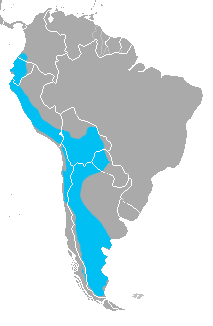Pampas cat
| Pampas cat | |
|---|---|
 |
|
| Pampas cat with the third pelage type (see text) | |
| Scientific classification | |
| Kingdom: | Animalia |
| Phylum: | Chordata |
| Class: | Mammalia |
| Order: | Carnivora |
| Family: | Felidae |
| Genus: | Leopardus |
| Species: | L. pajeros |
| Binomial name | |
|
Leopardus pajeros (Desmarest, 1816) |
|
 |
|
| Pampas cat range map | |
The Pampas cat (Leopardus pajeros) is a small cat native to Argentina, Chile, Bolivia, Peru, Ecuador, and possibly far southwestern Colombia. It is named after the Pampas, but occurs in grassland, shrubland, and dry forest at elevations up to 5,000 m (16,000 ft).
It has traditionally been included in the colocolo (L. colocolo), but was split primarily based on differences in pelage colour/pattern and cranial measurements. The split is not supported by genetic work, leading some authorities to maintain it as a subspecies of the colocolo. Confusingly, when the colocolo includes the Pampas cat and Pantanal cat as subspecies, the "combined" species is sometimes referred to as the Pampas cat.
The Pampas cat is currently classified as "Near Threatened" in the IUCN Red List as habitat conversion and destruction may cause the population to decline in the future.
Pampas cats have not been studied much in the wild and little is known about their hunting habits. There have been reports of the cat hunting rodents and birds at night, and also hunting domestic poultry near farms.
In 2005, Mammal Species of the World recognised five subspecies of the Pampas cat:
Based on two specimens, the subspecies L. p. steinbachi is larger and paler than P. l. garleppi. However, this is labelled with uncertainty due to the very small sample, and some treat it as a synonym of L. p. garleppi. Uncertainty also exists for the subspecies L. p. budini, which appears to resemble L. p. crespoi, and was described from lowlands of northwestern Argentina, but may actually be from humid forests in the region. Some recognise it, while other do not. Finally, populations in southern Chile and the southern half of Argentina, included in the nominate in the above list, have been recognised as the subspecies L. p. crucinus based on the large size (the largest Pampas cats) and dull pelage (third type, see Description).
...
Wikipedia

